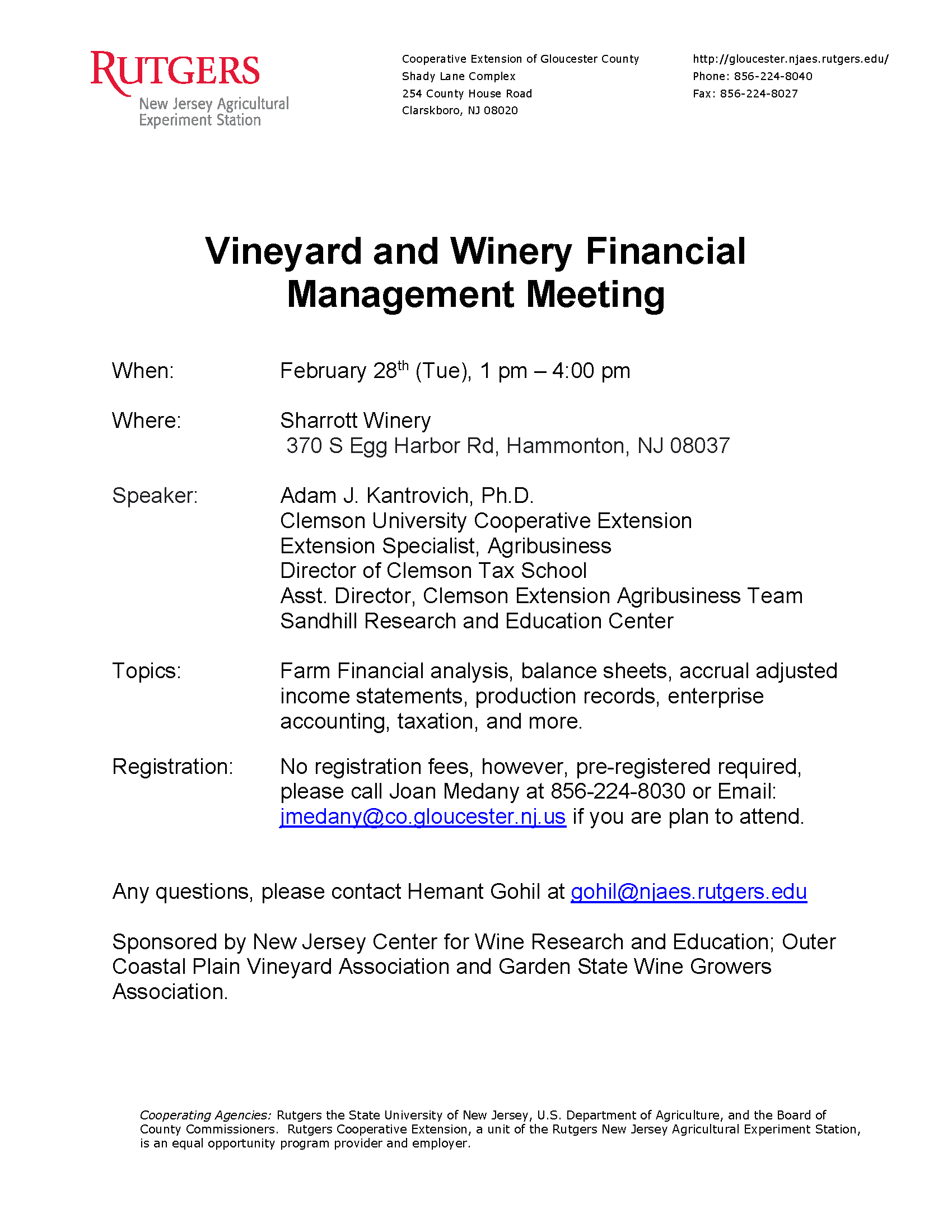Vegetable Crops Edition
Seasonal updates and alerts on insects, diseases, and weeds impacting vegetable crops. New Jersey Commercial Vegetable Production Recommendations updates between annual publication issues are included.
Subscriptions are available via EMAIL and RSS.
Quick Links:
 NJ Commercial Vegetable Production Recommendations
NJ Commercial Vegetable Production Recommendations
 Rutgers Weather Forecasting - Meteorological Information important to commercial agriculture.
Rutgers Weather Forecasting - Meteorological Information important to commercial agriculture.
National Pesticide Safety Education Month Focuses on Resources and Education to Support Safe Pesticide Handling and Use
Organic Grower Advisory 3/7 Registration Open
The Rutgers Organic Grower Advisory meeting will be held on March 7th. This meeting has served to increase communication between commercial farms using organic practices and Rutgers Cooperative Extension agricultural agents and specialists. This year the meeting will be held both in-person and online. We have a AV system that will allow for better sound quality for all participants. Please see details below, and use the Qualtrics link to register if you plan to attend.
March 7th 10:00 – 2:00
Rutgers Cooperative Extension of Mercer County
1440 Parkside Avenue, Ewing NJ 08638
OR Online via Zoom
In-person attendees will have a pizza lunch option at a cost of $5.00 per person, payable at the door.
Registration deadline is March 3rd, register here!
Examples of hot topics for discussion from the 2021 Organic Grower Advisory meeting are:
• Weed control updates
• Organic animal feed
• Allium leaf miner
• Spotted lanternfly
• Organic sweet corn
• Disease control
• Organic certifications
Central Jersey Vegetable Growers Meeting, February 24
Central Jersey Vegetable Growers’ Meeting
February 24, 2023: 8:30 am – 3:00 pm
Monmouth County Agricultural Building
4000 Kozloski Rd., Freehold, NJ 07728
Approved NJDEP Pesticide Credits
CORE – 2 credits
1A – 8 credits
PP2 – 8 credits
10 – 6 credits
Registration Fee: $25 (includes coffee, light refreshments in the morning and lunch)
Full Brochure and Registration form can be downloaded here: CJVGM brochure 2023
For registration questions, contact Cathy VanBenschoten at 732-431-7260 or email at Catherine.VanBenschoten@co.monmouth.nj.us
Note: This is an in-person event.
Agenda
8:30 am to 9:00 am:
Registration
9:00 am to 10:00 am (1 hour)
Pesticide Safety & Compliance Tools for Commercial Vegetable Growers
-Patricia Hastings
10:00 am to 10:30 am (30 minutes)
Field Trial Updates from the NJAES Specialty Crop Research and Extension Center
-William Errickson
10:30 am to 11:30 am (1 hour)
Updates on Vegetable Disease Control
-Andy Wyenandt, Ph.D.
11:30 am to 11:45 am (15 minutes)
Updates from the USDA NRCS and FSA
-Clare Flanagan
-Gabi Grunstein
11:45 am to 12:00 pm (15 minutes)
Grown in Monmouth
-John Ciufo
12:00 pm to 1:00 pm (1 hour)
LUNCH
1:00 pm to 1:15 pm (15 minutes)
RU Ready to Farm: Rutgers Beginner Farmer Program Update
-Brendon Pearsall
-Bill Hlubik
1:15 pm to 1:30 pm (15 minutes)
Food Safety Update
-Meredith Melendez
1:30 pm to 2:30 pm (1 hour)
Integrated Pest Management for Vegetable Growers
-Steve Rettke
2:30 pm to 3:00 pm (30 minutes)
Updates for Weed Management in Cole Crops
-Thierry Besancon, Ph.D
3:00pm
Pesticide Credits and Adjourn
North Jersey Commercial Vegetable Grower Meeting February 21
NORTH JERSEY COMMERCIAL VEGETABLE GROWERS MEETING
February 21, 2023
8:30 am – 3:00 pm
Hunterdon County Complex
314 State Rt. 12, Building #1
Flemington, NJ
Program Chair
Peter Nitzsche, Agriculture and Resource Management Agent
Cooperative Extension of Morris County
8:30 – Registration
Coffee and pastry compliments of industry sponsors
9:00 – Welcome and Introductions
9:10 – Trends in Diamondback Moth Management in Cole Crops
Kris Holmstrom, Research Project Coordinator, Cooperative Extension
9:40 – Update on Farm Service Programs
Speaker TBA, Farm Service Agency
9:50 – Jersey Fresh Marketing Update
Speaker TBA, Division of Markets, NJ Dept. of Agriculture
10:10 – Update on Farm Labor Issues
Ben Casella, Field Representative, New Jersey Farm Bureau
10:30 – Updates on Diseases of Fresh Market Vegetables and their Control
Andy Wyenandt, Specialist in Vegetable Pathology, Cooperative Extension
11:00 – What is New from Industry
11:10 – Strategies to Protect Farmer Safety and Health as the Field Season Approaches
Kate Brown, Program Associate, Cooperative Extension of Burlington County
11:40 – Update on Weed Management Tools and Strategies for New Jersey Cole Crops
Thierry Besançon, Specialist in Weed Science, Cooperative Extension
12:10 – LUNCHEON (pre-registration required)
1:10 – Protective Equipment for Pesticide Safety
Patricia Hastings, Pesticide Safety Education Program Coordinator, Cooperative Extension
1:40 – Growing Ginger and Turmeric in NJ
William Errickson, ANR Agent Cooperative Extension of Monmouth County
2:10 – A Tour of the California Strawberry Nursery Industry
Peter Nitzsche, ANR Agent, Cooperative Extension of Morris County
2:40 – Pesticide Recertification Credits and Adjourn
THE FOLLOWING NJDEP PESTICIDE RECERTIFICATION CREDITS WILL BE OFFERED
1 CORE 3 CAT 1A 3 CAT 10 3 PP2
All Registration and Lunch Fees (Cash or Check) will be collected at the door
Please make checks payable to: Rutgers The State University of New Jersey
Registration Fees $20.00 per meeting
Additional Registrants $10.00 each per meeting
Lunch Fees $25.00 per person per meeting
RSVP by February 17, 2023
RSVP to Kim Crommelin 908-788-1338
kfrey@co.hunterdon.nj.us

